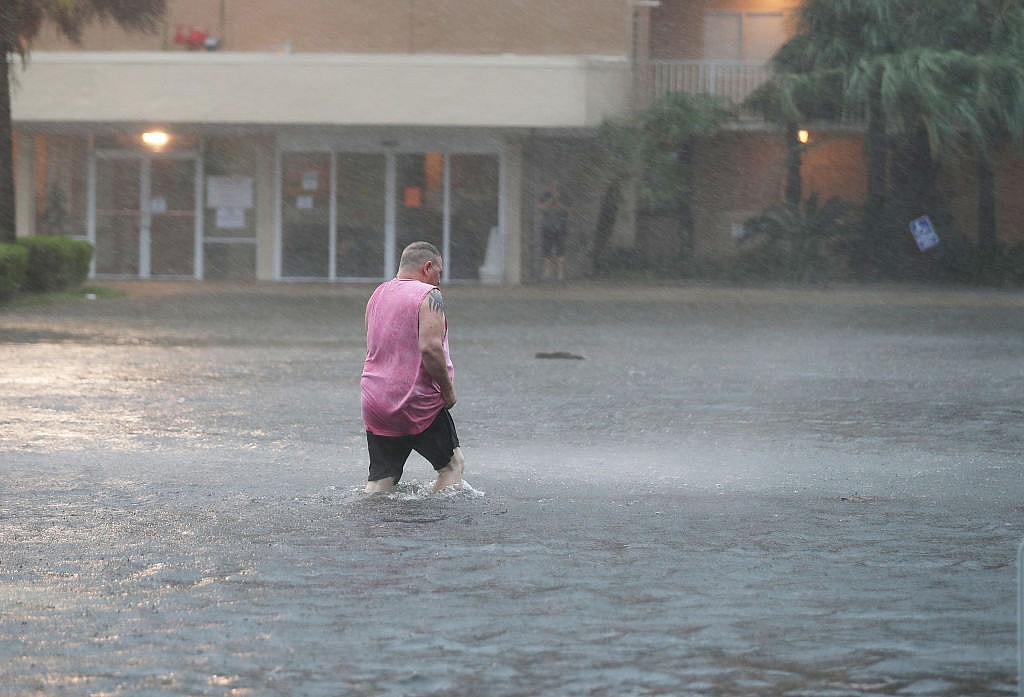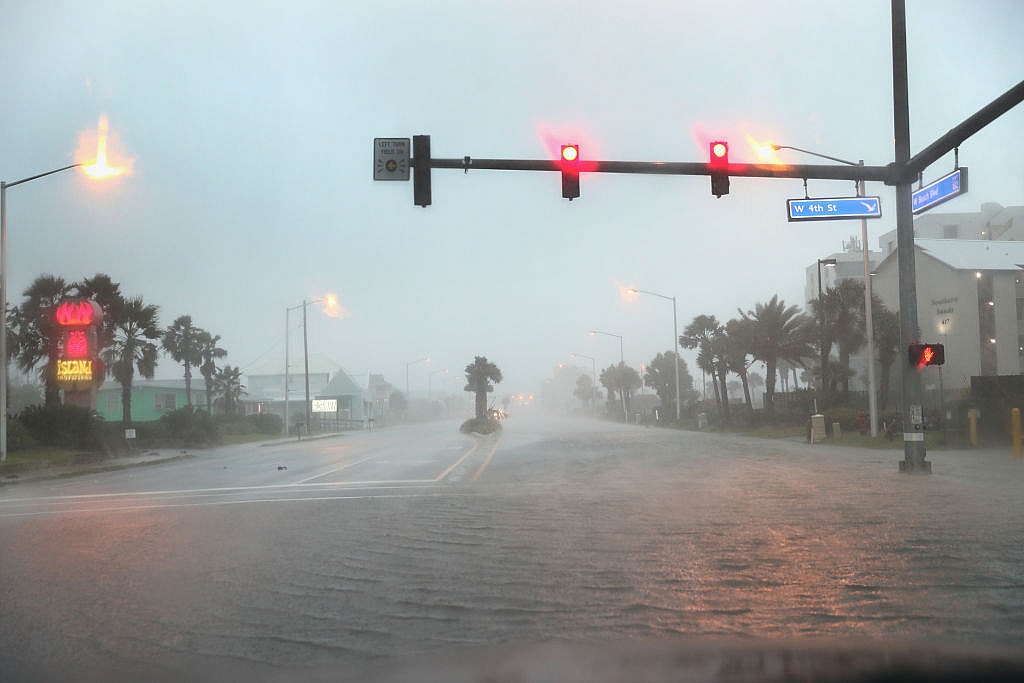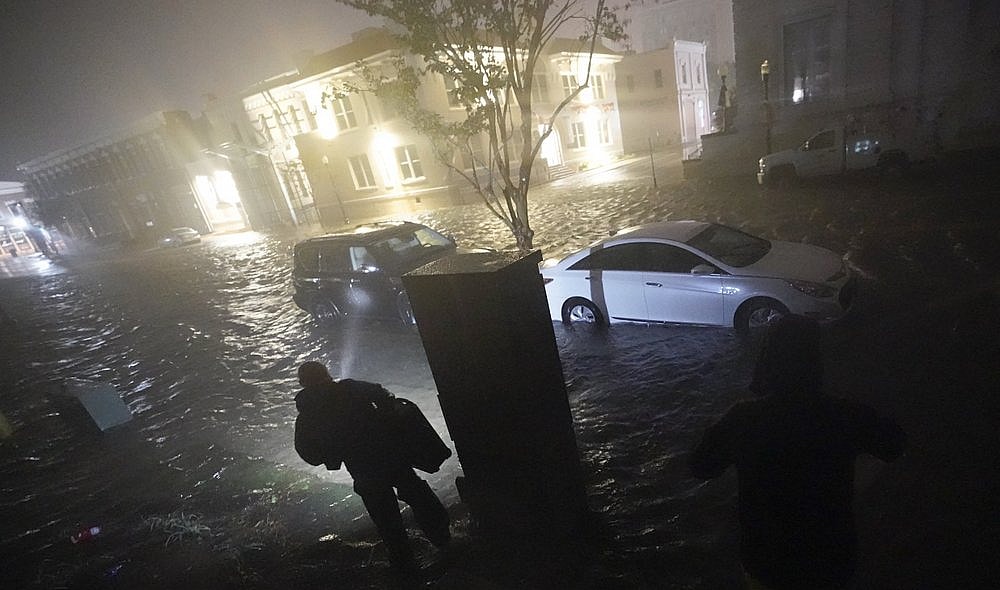PENSACOLA, Fla. (AP) — Hurricane Sally lumbered ashore in Alabama with 105 mph (165) winds Wednesday, shoving a surge of seawater onto the coast and bringing torrential rain that forecasters warned will cause dangerous flooding from the Florida Panhandle to Mississippi and well inland in the days ahead.
Moving at an agonizingly slow 3 mph, the storm made landfall at 4:45 a.m. near Gulf Shores after raking the Gulf Coast with hurricane-force winds and rain from Pensacola Beach, Florida, westward to Dauphin Island, Alabama, for hours.
Read More: Southern Gulf states prepare for another storm
Emergency officials in Alabama and Florida reported flash floods that pushed water into people’s home. More than 2 feet of rain (61 centimeters) was recorded near Naval Air Station Pensacola, and forecasters said some coastal spots could get nearly 3 feet (1 meter).
“It’s not common that you start measuring rainfall in feet,” said National Weather Service forecaster David Eversole in Mobile, Alabama. “Sally’s moving so slowly, so it just keeps pounding and pounding and pounding the area with tropical rain and just powerful winds. It’s just a nightmare.”

Street lights were knocked out in downtown Mobile, where a stoplight snapped, swinging wildly on its cable. Trees were bent over as the rain blew sideways in the howling wind. In downtown Pensacola, car alarms went off, the flashing lights illuminating the floodwaters surrounding parked cars.
Before sunrise, water was up to the doors of Jordan Muse’s car outside the Pensacola hotel where her family took shelter after fleeing their mobile home a few miles away. The power failed early in the morning, making it too stuffy to sleep. Her 8-year-old son played with toys underneath the hotel room’s desk as Muse peered out the window, watching rain fly by in sheets.
“The power trucks are the only ones above water, and they’re the biggest,” Muse said. “I can’t believe it got so bad. That’s why we came here.”
Nearly a half-million homes and businesses had lost electricity by early Wednesday, according to the poweroutage.us site. A curfew was imposed in Gulf Shores hours before the storm’s arrival. Florida officials shut down a section of Interstate 10 near Pensacola because of high winds.
In the Panhandle’s Escambia County, Chief Sheriff’s Deputy Chip Simmons vowed to keep deputies out helping residents as long as possible. The county includes Pensacola, one of the biggest cities on the Gulf Coast.
“The sheriff’s office will be there until we can no longer safely be out there, and then and only then will we pull our deputies in,” Simmons said late Tuesday.
This for a storm that, during the weekend, appeared to be headed for New Orleans, about 200 miles (320 kilometers) to the west.
“Obviously this shows what we’ve known for a long time with storms — they are unpredictable,” Pensacola Mayor Grover Robinson IV said.
National Hurricane Center forecaster Stacy Stewart said the rain will be “catastrophic and life-threatening” over portions of the Gulf Coast, Florida Panhandle and southeastern Alabama.
The storm still had winds of 100 mph (155 kph) more than two hours after it reached land. Forecasters warned that heavy rainfall would continue into Thursday as the storm moved inland over Alabama and into central Georgia, with the threat of serious flash flooding.
“Sally has a characteristic that isn’t often seen and that’s a slow forward speed, and that’s going to exacerbate the flooding,” said Ed Rappaport, deputy director of the hurricane center.

He likened the storm’s plodding pace to that of Hurricane Harvey, which swamped Houston in 2017.
Sally’s effects were felt all along the northern Gulf Coast. Low-lying properties in southeastern Louisiana were swamped by the surge. Water covered Mississippi beaches and parts of the highway that runs parallel to them. Two large casino boats broke loose from a dock where they were undergoing construction work in Alabama.
In Orange Beach, Alabama, Chris Parks, a tourist from Nashua, New Hampshire, spent the night monitoring the storm and taking care of his infant child as the winds battered his family’s hotel room. Their return flight home was canceled, so they were stuck in Alabama until Friday.
“I’m just glad we are together,” Parks said. “The wind is crazy. You can hear solid heavy objects blowing through the air and hitting the building.”
As Sally’s outer bands reached the Gulf Coast, Tom Parker, manager of an alligator ranch in Moss Point, Mississippi, hoped he wouldn’t see a repeat of what happened at the gator farm in 2005, when about 250 alligators escaped their enclosures during Hurricane Katrina’s storm surge.
Read More: Hurricane Laura destroys Confederate monument after officials vote to keep it
President Donald Trump issued emergency declarations for parts of Florida, Alabama, Mississippi and Louisiana.
Sally hit just shy of three weeks after Hurricane Laura pummeled southwestern Louisiana on Aug. 27. Thousands of people were still without power from that storm, and some were still in shelters.
Meanwhile, far out in the Atlantic Tropical Storm Teddy became a hurricane with winds of 100 mph (160 kph). It was situated more than 800 miles (1,300 km) east of the Lesser Antilles. Forecasters said it was likely to become a major hurricane, reaching Category 4 strength on Thursday.
___
Wang reported from Mobile, Alabama and Martin, from Marietta, Georgia. Associated Press contributors include Russ Bynum in Savannah, Georgia; Sophia Tulp and Haleluya Hadero in Atlanta; Tamara Lush in St. Petersburg, Florida; Rebecca Santana in New Orleans; Emily Wagster Pettus in Jackson, Mississippi; Kim Chandler in Montgomery, Alabama; and Julie Walker in New York City.
Have you subscribed to theGrio’s new podcast “Dear Culture”? Download our newest episodes now!


